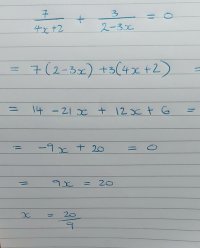You are using an out of date browser. It may not display this or other websites correctly.
You should upgrade or use an alternative browser.
You should upgrade or use an alternative browser.
hey just need to know if im on the right track with this: 7/(4x+2) + 3/(2 - 3x) = 0
- Thread starter MrBubbles
- Start date
- Joined
- Feb 4, 2004
- Messages
- 16,582
so im to solve, and state assumptions on x.View attachment 37039
i am i on the correct track?
You can check the answer to any "solving" exercise by plugging your value back into the original problem. If your case, you want to see if [imath]x = \frac{20}{9}[/imath] makes the original equation true. So check, plugging into the left-hand side:
[imath]\qquad \dfrac{7}{4\left(\frac{20}{9}\right) + 2} + \dfrac{3}{2 - 3\left(\frac{20}{9}\right)}[/imath]
[imath]\qquad \dfrac{7}{\left(\frac{98}{9}\right)} + \dfrac{3}{\left(\frac{-42}{9}\right)}[/imath]
[imath]\qquad \left(\frac{7}{1}\right)\left(\frac{9}{98}\right) + \left(\frac{3}{1}\right)\left(-\frac{9}{42}\right)[/imath]
[imath]\qquad \frac{9}{14} - \frac{9}{14}[/imath]
[imath]\qquad 0[/imath]
So the solution checks.
so im to solve, and state assumptions on x.
i am i on the correct track?
suki, you are certainly on the right track, with a correct final solution,
and you were shown how your solution checks. Let me write a slight
redo with certain equals signs that do not belong. Also, let me
address the "assumptions on x" you mentioned.
\(\displaystyle \dfrac{7}{4x + 2} \ + \ \dfrac{3}{2 - 3x} \ = \ 0 \)
\(\displaystyle 7(2 - 3x) \ + \ 3(4x + 2) \ = \ 0\)
\(\displaystyle 14 - 21x + 12x + 6 \ = \ 0 \)
\(\displaystyle -9x + 20 \ = \ 0\)
\(\displaystyle 9x \ = \ 20 \)
\(\displaystyle x \ = \ \dfrac{20}{9} \)
-------------------------------------------------------------------------------------------------------------
For the fractions in the first line, neither denominator may equal zero.
We can find out restrictions on x by stating each denominator is not
equal to zero and solve that respective nonequation:
\(\displaystyle 4x + 2 \ne 0\)
\(\displaystyle 4x \ne -2\)
\(\displaystyle x \ne \dfrac{-1}{2} \)
Also,
\(\displaystyle 2 - 3x \ne 0 \)
\(\displaystyle -3x \ne -2 \)
\(\displaystyle x \ne \dfrac{2}{3} \)
---------------------------------------------------------------------------------------
Notice how the solution of \(\displaystyle \ x \ = \ \dfrac{20}{9} \ \) is different from either of
these two restricted values.

